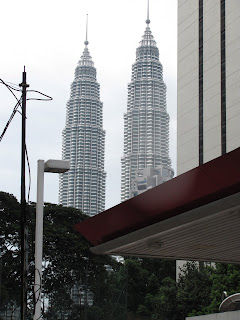
Everyone know that the only reason that anyone ever chooses to be a professor is that we get three months off every summer. As most of you know, I generally make pretty good use of my summer vacations. In a tropcial country like Malaysia (KL is located about 8 degress north of the equator), there is no "summer" or "winter" (instead I think that they have dry and wet seasons), so things run on a different schedule. The new school term at universities in Malaysia starts today, which means my summer vacation is over (what a rip off)! So I decided to make the most of my last day of summer vacation by playing tourist in KL; I visited Batu Caves and the National Zoo.
Batu CavesBatu Caves is a series of very large caves located in a limestome outcrop about 8 miles north of KL. The largest cave, Cathedral Cave, is 100 meters high with openings in the ceiling that let natural light into the cave (even with my calustophic dislike of caves I had no trouble here). Batu Caves is the location of an important Hindu shrine.
You are greeted by a 140 foot tall staue of the Hindu deity Murugan. (according to Wikipedia, this statue contains 1550 cubic metres of concrete, 250 tons of steel bars and 300 litres of gold paint and took three years to build). You have to climb 272 steps to reach the cave (I counted until about 20 steps, but then I got bored so I will take Wikipedia's word- it was a lot of steps).
Looking Down

Looking Up

Once you get inside of the cave (which is magnificent, and as usual, none of the photos I took could do it justice) there is a temple and in every nook and cranny there are little statues that tell the stories such as Murugan's victory over the demon Soorapadam.

Along the stairway and inside the cave their are a large number of macaques(monkeys) that people feed coconuts, peanuts, bananas, etc. I am such a Texas boy that seeing these obviously overly-familiar-with-human monkeys was still exciting to me.


Each year Thaipusam, a Hindu holiday, attracts large numbers of visitors to Batu Caves (up to 800,000!!). Because Thaipusam occurs in January or February, I will give a full report on this holiday then (it looks pretty wild). I am pretty sure that even in Catherdral Cave I would feel claustrophic sharing the cave with 800,000 of my closest friends!
For more info about Batu Caves you can check out
http://en.wikipedia.org/wiki/Batu_Caves.
National Zoo (Zoo Negara)Because I am here to learn more about the flora, fauna, and ecology of Malaysia, I was excited to get a change to visit the National Zoo. It was quite a nice zoo and I was able to see several of the Malaysian species that I have only been able to read about so far.
By the time we got to the zoo it was warming up in the middle of the afternoon. Most of the Malaysian animals were smart enough to be just chillin' out in the shade. Surprisingly, the animals from North America, in particular the mountain lions, were the most active animals at the zoo. I think they feel like I do- "I am not going to feel cool here even while resting in the shade, so I may as well be active and enjoy life".
Here are some shots of my favorites.
Asian Elephant

Guar

Orangutan

You can find more information about the National Zoo at
http://www.zoonegara.org.my/index.htm





















































